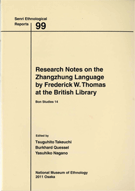Senri Ethnological Reports (SER)
 No.99 Research Notes on the Zhangzhung Language by Frederick W. Thomas at the British Library (Bon Studies 14)
No.99 Research Notes on the Zhangzhung Language by Frederick W. Thomas at the British Library (Bon Studies 14)
March 22, 2011 Publication
Edited by Tsuguhito Takeuchi, Burkhard Quessel, Yasuhiko Nagano
back numbersTable of Contents
Preface
……………… Yasuhiko Nagano Introduction
……………… Tsuguhito Takeuchi
……………… Yasuhiko Nagano Introduction
……………… Tsuguhito Takeuchi
Chapter 1 Introductory and Geographical
(1) Geographical
Chapter 2 Historico-geographical
(1) Himalaya in early Indo-Aryan history
(2) Cis-Himalayan peoples and territories
(3) Trans-Himalayan peoples and territories
(3a) Areas of the Ladakh State
(3b) rnṄaḥ-ris-skor (khor)-gsum
(2) Cis-Himalayan peoples and territories
(3) Trans-Himalayan peoples and territories
(3a) Areas of the Ladakh State
(3b) rnṄaḥ-ris-skor (khor)-gsum
Chapter 3 Ethnographical
(1) General views
(1a) Hodgson
(1b) Cunningham
(1c) 'Muṇḍā' views in the Linguistic Survey of India
(1d) Przyluski's 'Austro-Asiatic' view
(1e) Khasa theory
(2) Some remarks on the two wide views
(3) Indications in early Sanskrit literature
(4) Modern observations and deductions
(4a) Cis-Himalayan regions
1. Two generalities
2. Ethnographically significant usages
3. Kanets: status and usages (general)
4. Kanets: distinctive usages
5. Three main areas of Western cis-Himālaya populations
6. Origins (traditional or hypothetic) of Ghirths Rāṭhīs and Kanets
7. Kanets and Kuṇindas (with Taṅgaṇas)
8. Kanet divisions (Khash and Rao)
9. Khaśas and Nepal Khas
10. Kirātas
11. 'Menial' classes
12. Bhotias
(4b) Trans-Himalayan territories
1. Anthropological date and deductions
2. Tibetan and other extrinsic items in nomenclature of peoples and classes
3. Material analogies between Trans and Cis-Himālayan conditions
4. Beda and Mon
5. Early relations with outside peoples
6. Hunza-Nagar
7. Khotan and Kashmir
8. Bru-śa and Balti
(1a) Hodgson
(1b) Cunningham
(1c) 'Muṇḍā' views in the Linguistic Survey of India
(1d) Przyluski's 'Austro-Asiatic' view
(1e) Khasa theory
(2) Some remarks on the two wide views
(3) Indications in early Sanskrit literature
(4) Modern observations and deductions
(4a) Cis-Himalayan regions
1. Two generalities
2. Ethnographically significant usages
3. Kanets: status and usages (general)
4. Kanets: distinctive usages
5. Three main areas of Western cis-Himālaya populations
6. Origins (traditional or hypothetic) of Ghirths Rāṭhīs and Kanets
7. Kanets and Kuṇindas (with Taṅgaṇas)
8. Kanet divisions (Khash and Rao)
9. Khaśas and Nepal Khas
10. Kirātas
11. 'Menial' classes
12. Bhotias
(4b) Trans-Himalayan territories
1. Anthropological date and deductions
2. Tibetan and other extrinsic items in nomenclature of peoples and classes
3. Material analogies between Trans and Cis-Himālayan conditions
4. Beda and Mon
5. Early relations with outside peoples
6. Hunza-Nagar
7. Khotan and Kashmir
8. Bru-śa and Balti
Chapter 4 Linguistic
(1) Cis-Himalayan areas
(1a) Indo-Aryan languages
1. Dating oflndo-Aryan languages
2. Early and other loan-words in, or from, Indo-Āryan: preservation of old forms
3. A wide-spread phonetic change
(1b) Tibeto-Burman languages
1. Bhotiya
2. The 'Western pronominalized 'sub-group'
3. Geographical distribution of the 'Western sub-group'
4. Bhot and Bhotiya
5. The 'Western sub-group' and its pronominalization
6. Kunāwarī, bibliography, names and dialects
7. Kunāwarī, a phonological item
8. Kunāwarī Grammars and Vocabularies
9. Class-features and interrelations in the 'Westrn sub-group'
10. Some features of the 'Western sub-group' in relation to Tibetan
11. Suffixed elements in Declension and Conjugation
(2) Trans-Himalayan territories
(2a) General
(2b) Bru-śa
(2c) Zaṅ-Zuṅ
(2d) Summary
(1a) Indo-Aryan languages
1. Dating oflndo-Aryan languages
2. Early and other loan-words in, or from, Indo-Āryan: preservation of old forms
3. A wide-spread phonetic change
(1b) Tibeto-Burman languages
1. Bhotiya
2. The 'Western pronominalized 'sub-group'
3. Geographical distribution of the 'Western sub-group'
4. Bhot and Bhotiya
5. The 'Western sub-group' and its pronominalization
6. Kunāwarī, bibliography, names and dialects
7. Kunāwarī, a phonological item
8. Kunāwarī Grammars and Vocabularies
9. Class-features and interrelations in the 'Westrn sub-group'
10. Some features of the 'Western sub-group' in relation to Tibetan
11. Suffixed elements in Declension and Conjugation
(2) Trans-Himalayan territories
(2a) General
(2b) Bru-śa
(2c) Zaṅ-Zuṅ
(2d) Summary
Chapter 5 The language of the medical Mss.




